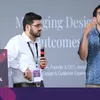Future of Work 2020: Industry veteran Shivananda Koteshwar explains how design thinking can help bring back ‘R’ in R&D
In his talk at Future of Work 2020, Shivananda says ‘research’ is not the same as ‘re-search’ and that most of the R&D happens only in the ‘D’ part.
“Today, in an industry focussed on advancements in technology, most of the businesses rely on innovation in R&D to maintain its relevance in the market. But, unfortunately, most of the R&D happens only in the ‘D’ part - that is, in the area of development. In R&D teams in India, a lot of effort happens in the development part and very less in research,” said Dr Shivananda Koteshwar, Group Director & RD head, Synopsys Inc., as he set the tone for his talk on ‘How design thinking can help bring back the ‘R’ in R&D’ at Future of Work 2020, YourStory’s flagship conference for product, design and technology.

Fundamental difference in R&D
Dr Shivananda Koteshwar (Shivoo as he popularly known) has led extensive work in full-chip and complex IP implementation, verification and design methodologies, and has been instrumental in delivering multiple first-time-right silicon ASICs.
He was also instrumental in setting up MediaTek, Bangalore site, and in defining growth strategies, creating innovation capabilities, enabling ecosystems and building breakthrough business models.
As a technology leader, his career spans decades in strategic development and operation as well as in driving innovation and design. In his talk he took the audience through the difference between research and development.
He said, “While development involves transforming ideas into a product fit for market, the research process involves the discovery of new ideas to solve problems or create opportunities.” He emphasised, “Research is not the same as ‘Re-Search.’’
Why India lags in R&D
In 2016, the global spending on R&D was $1.7 trillion, an indication of the scale of investments in R&D. As part of the Sustainable Development Goals (SDGs), countries have pledged to substantially increase public and private R&D spending, as well as the number of researchers by 2030. As of 2019, the United States was expected to invest about $581 billion into research and development.
“That said, if you look at where India stands at R&D investments, it is just 0.8 percent of the GDP as compared with US where it is 2.7 percent or Israel with 4.2 percent. That’s not all. The other biggest difference that also comes into play is that while in China, a country that shares a similar economic climate like India, most of the R&D investments come from businesses. The businesses in China contribute about $287K million in investments when compared with the government - $58K million. In India, it is the other way round. Government contributes $29K million while businesses contribute $17K million.” He explained that this was one of the key reasons why India was lagging in the innovation index.
Role of Design Thinking
Experts believe that today we are reaching the end of the runway on maximising productivity and re-engineering processes. While many believe in rethinking how businesses can deliver the solution and rethink how they can leverage technology will continue to drive growth and value, it will be incremental in nature.
It is here that Shivoo says that innovation can up the ante. “This is where the role of design thinking comes into the spotlight. What TQM did for quality, design thinking can do for organic growth and innovation. Because design thinking brings more than just a set of principles; it also brings a methodology and a collection of tools that can help us realise our aspirations.”
Role of IP in innovation and growth
Shivananda shared the example of ARM, the world's leading semiconductor intellectual property (IP) supplier and how the company has devised an innovation growth model. ARM has sold 900 licenses to more than 250 different partner companies. ARM receives a license fee for the original IP from the partner and a royalty on every microchip produced. To date, over 20 billion chips containing ARM technology have been manufactured.
“How ARM built this growth model was by leveraging R&D. While ARM’s product development team looks at a time frame of 1-2 years to develop and launch product, its corporate R&D team looks at time-frame of 5-10 years to do new things. The other element of its growth model has been its focus on IP.”
Given that technology is becoming integral to every business, Shivananda believes that businesses must work towards developing technology keeping the future in sight.
“And, for businesses that is about 5-10 years, not the next 6 months of 1 year. When you do so and work towards it, it is possible that you will develop technology that is groundbreaking. But, don’t stop there. File your IPs. Because once you develop a technology that will be relevant in the future, you need to capitalise on it. For which, IP will be very important.”
He advised startups to hire at least one person or team focused on research and patents to weather the volatile tech evolution. He added, “Today AI in healthcare is one area which has seen the highest number of patents in the last few years. When I researched further, I saw FinTech has the lowest number of patents. This is a huge opportunity for FinTech startups in India. By investing in R&D and filing patents, they can drive growth and competitive advantage.”
Future of work: Skills that will gain relevance
As much as it is important for startups and businesses to focus on innovation, they must also ensure the workforce is skilled to meet the ever-changing demands on the industry.
“Today, we are seeing people upskilling in specialised marketing, statistical, programming and financial skills. But these are in fact the least important skills to upskill. So, what then are important skills that businesses must turn their attention to? The answer is skills like time management, ability to work with a wide variety of people, ability to network and most importantly ability to solve problems -- all of which can be enhanced with design thinking.”
Closing his talk, he said he had one key advice, specifically for R&D engineers, “I want you to give emphasis on “R” in your day-to-day work. This is the only way we can go up the value chain and be closer to technology and thus be closer to customers.”
(Edited by Javed Gaihlot)
A big shout out to our Future of Work 2020 Sponsors: Alibaba Cloud, Larksuite, Vodafone Idea Limited, Gojek, Adobe, , , , , , , Maharashtra State Innovation Society, and GetToWork; and our Knowledge Partner: Ascend Harvard Business Review









